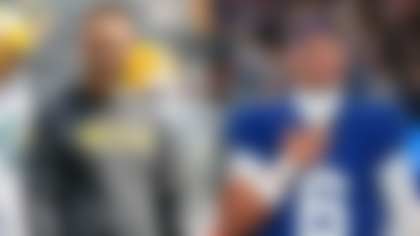Former NFL player and scout Bucky Brooks knows the ins and outs of this league, providing keen insight in his notebook. Today's installment covers:
But first, a look at a polarizing player who is in position to leave no doubt about his greatness ...
While the pecking order among the top four quarterbacks in football today is debatable, everyone generally agrees on who comprises the position's current Mount Rushmore: Josh Allen, Joe Burrow, Lamar Jackson and Patrick Mahomes. But I think this is the year when Justin Herbert joins that elite tier of signal-callers.
While that proclamation undoubtedly makes the naysayers cringe, the football world has been waiting for Herbert to level up after teasing us with immense talent and potential since his arrival as the sixth overall pick in the 2020 NFL Draft. Winning the Offensive Rookie of the Year award in his debut campaign and earning Pro Bowl honors in Year 2, the Los Angeles Chargers star ultimately piled up the most passing yards in league history through the first five seasons of a career (21,093), showcasing exceptional arm talent, accuracy, touch and timing.
Standing 6-foot-6 and 236 pounds with outstanding athleticism, agility and body control, Herbert flummoxes foes with his ability to thrive from the pocket or on the move. In addition, he can produce crucial first downs on designed quarterback runs or impromptu scrambles that leave defenders bewildered on how to handle a supersized quarterback with superhero abilities.
Given Herbert's rare talents, it is not surprising that Chargers head coach Jim Harbaugh constantly waxes poetic about his proficient pupil.
"I would follow him to hell and back," Harbaugh said during an appearance on PFT Live back in February. "I've never been around a competitor quite like him. Some great ones, but, you know, no doubt in my mind that Justin Herbert is not only one of the great quarterbacks in the NFL today but truly one of the great quarterbacks of all time."
The 27-year-old owns a 42-38 career mark, averaging 267.6 passing yards per game while accumulating a 140:45 touchdown-to-interception ratio. As an efficient passer with great command of the football, Herbert has completed 66.6 percent of his passes and compiled a 97.1 passer rating through 80 career games.
While the haters will ignore Herbert's sparkling numbers and immediately point to his playoff woes -- 0-2 record, with one loss where the Chargers blew a 27-0 lead and another defeat in which Herbert threw four interceptions -- a larger film study reveals a gifted player who consistently raises the level of play of those around him.
Despite losing his WR1 (Keenan Allen) and WR2 (Mike Williams) prior to last season, Herbert still excelled in Year 1 under Harbaugh. He finished with the highest passer rating (101.7) and lowest interception percentage (0.6) of his career. Moreover, he played the winning brand of football that Harbaugh demands, while flashing enough "take over the game" ability to convince his head coach that he can put the team on his back when needed.
"This is the truth: Justin Herbert's biggest weakness is all of those that he's counting on on offense -- coaches, offensive line, playmakers, receivers, running backs -- to get up to his level," Harbaugh said during NFL Network's Back Together Weekend in July. "I wake up every day to try to get to his level."
After seeing Herbert's dominant performance in the season-opening win over the Kansas City Chiefs last week in Brazil, it is easy to envision the sixth-year pro making a Josh Allen-like run at MVP. Last season, the Buffalo Bills' QB1 claimed the league's most prestigious individual award by chalking up wins without mind-bending stat lines. Though Allen provided plenty of spectacular highlights while guiding the Bills to a fifth straight division title, he earned the hardware with a "less is more" approach that led him to play more like a pass-first point guard than a take-it-to-the-hole scorer for his squad.
In Los Angeles, the Chargers need Herbert to operate as a distributor to maximize their offensive potency and contend for a division title in an extremely competitive AFC West. Fresh off a win over the Chiefs, who've won the past nine division crowns, the Bolts are visiting the upstart Raiders for a Monday night showdown in Las Vegas. And Herbert has the kind of firepower to beat any team. With a pair of big backs (Omarion Hampton and Najee Harris) and a trio of pass catchers with the complementary skills to tax defensive coordinators (Ladd McConkey, Quentin Johnston and Allen, who returned to the franchise in August), Herbert simply needs to make sound decisions in support of Jesse Minter's stingy defense in order for the Bolts to win games. Though the football world has romanticized the QB position as a one-man show, Herbert has the supporting cast to toe the line between "game manager" and "playmaker" in 2025.
We've all seen Harbaugh win big with Andrew Luck, Alex Smith, Colin Kaepernick and J.J. McCarthy operating primarily as distributors. Herbert can enjoy a career year by following a familiar blueprint that demands the quarterback focus on smart play instead of stat-stuffing. And if he guides the Chargers to new heights, Herbert will earn serious MVP consideration.
Don't sleep on Indy: Why Colts are LEGIT
We have seen exactly one game from the 2025 Indianapolis Colts, but my eyes are already telling me this team is poised to end a four-season playoff drought -- with none other than Daniel Jones unlocking the potential of an offense loaded with athletic freaks on the perimeter.
Yes, I can hear you snickering. I know the sixth overall pick in the 2019 NFL Draft flamed out with the Giants and ended the 2024 regular season on the Vikings' practice squad. And I know we have to keep the Colts' season-opening 33-8 drubbing of the Dolphins in perspective. But there is real reason to believe the veteran QB might have landed in the perfect spot, with Shane Steichen cleverly crafting an offense that accentuates Jones' talents as a dual-threat playmaker.
While Jones is not an athlete on par with Lamar Jackson or Jalen Hurts, he is a legitimate threat with the ball in his hands on designed quarterback runs and scrambles. He's also an efficient rhythm passer with the pocket skills to punish defenses who overload the box in an effort to neutralize RB Jonathan Taylor. Blessed with the hands of a middle infielder and a swift release, Jones can torch opponents with quicks and intermediate throws tossed between the numbers. In Week 1, Jones' anticipation and awareness stood out on tape as he repeatedly peppered the Dolphins with pinpoint throws on post-corners and wheel routes near the boundary, completing 76 percent of his passes for 272 yards and a score (plus two rushing TDs).
Jones is also still just a few weeks into his tenure as QB1, a title he claimed after a preseason competition with Anthony Richardson. As he continues to grow more comfortable with Michael Pittman Jr., Josh Downs, Alec Pierce, Adonai Mitchell and rookie Tyler Warren, Indy could pose problems for opponents unable to match the dynamic pass-catching crew's individual and collective strength, speed and explosiveness. Throw in Taylor's big-play potential from the backfield, and the Colts' offense suddenly looks like a dangerous unit with a seasoned signal-caller at the helm.
The emerging offense isn't the only enticing unit on this team, either -- the Colts' opportunistic defense could also help make the postseason a reality. New coordinator Lou Anarumo is a game-planning wizard with a voluminous playbook featuring myriad fronts, coverages and blitzes that create sleepless nights for opponents. We can expect the veteran coach to ensure his tactics maximize Indianapolis' talent without overloading his players' minds.
Against the Dolphins, Anarumo routinely had a second-level defender coming off the edge as part of a simulated pressure (four-man rush) or five-man blitz, keeping Miami guessing at the line. He enhanced the exotic pressure package with a few "drop eight" coverage calls that dared Tua Tagovailoa to squeeze passes into tight windows guarded by defenders maintaining vision on the quarterback.
Indianapolis' D is loaded with speedsters and underappreciated playmakers capable of reacting quickly, and last Sunday, they repeatedly swatted away passes or punished pass catchers venturing between the hashes, holding Tagovailoa to 114 passing yards and a passer rating of 51.7. The perfectly executed cat-and-mouse game showcased Anarumo's play-calling talents while providing a glimpse of what the Colts could become once each member of the defense fully settles into his role.
With a collection of versatile, high-IQ defensive backs (Charvarius Ward, Kenny Moore, Camryn Bynum, Xavien Howard, Nick Cross and Rodney Thomas) and a mix of speedy pass rushers (Kwity Paye, Laiatu Latu and Samson Ebukam) to complement a beefy interior built around DeForest Buckner, the Colts have the pieces in place to establish themselves as complementary football masters on the way to double-digit wins.
Obviously, a single stellar game does not make a season, and this Sunday's matchup against the Denver Broncos will provide a stiffer test. But that impressive opening showing should buoy hopes that the Colts will make their way back into the playoff picture.
Return of fun: Kickoff tweak bearing fruit
Back in July, the NFL announced a small tweak to the so-called dynamic kickoff -- moving touchbacks from the 30-yard line to the 35 -- in hopes of increasing the rate of returns. One week into the 2025 season, the league is certainly getting what it wanted. Teams returned 75.6 percent of kickoffs in Week 1, the highest rate in any week since the 2010 season. That's an enormous increase from last year's rate of 32.8 percent.
As a former kick returner myself, I'd love to see the kickoff re-emerge as one of the most exciting plays in the game. An increase in returns enables a bunch of running backs and wide receivers to get more touches, while taking advantage of big-play opportunities against coverage units in the NFL's dynamic-kickoff format, which is now in its second season.
By rule, the blockers and coverage players are positioned 5 yards apart on the plus side of the field. The setup makes the kickoff more like a scrimmage play, with one-on-one or trap blocks executed at the point of attack to create seams for runners. Additionally, the one-wave coverage unit makes the kick return more like a punt return, where one missed tackle can lead to a touchdown due to a cluster of bodies at the same level.
Given the formation and the dynamics of the play, team-builders are loading up kickoff coverage and return teams with linebackers, safeties, tight ends and running backs. The mid-size skill players are accustomed to stalk blocking and violently disengaging in space, making them ideally suited to engage in shadowboxing around the 35-yard line. Running backs and wide receivers are best equipped to fill the role of returner. The job requires a combination of vision, open-field running ability and burst. The physicality endured by the returner has prompted some teams to utilize bigger wideouts and rugged running backs as catchers in the return game.
It's possible this significant rise in returns is the product of teams still figuring out how to approach the rule tweak, and we ultimately could be headed for a more conservative approach that spawns more touchbacks. But I sure hope not. By allowing opponents to start at the 35-yard line, you're putting them within a few first downs of field-goal range. That's a difficult strategy for many coaches to square. So I hope kickers continue to put the ball in the landing zone, allowing for the widespread return of an exhilarating play.












